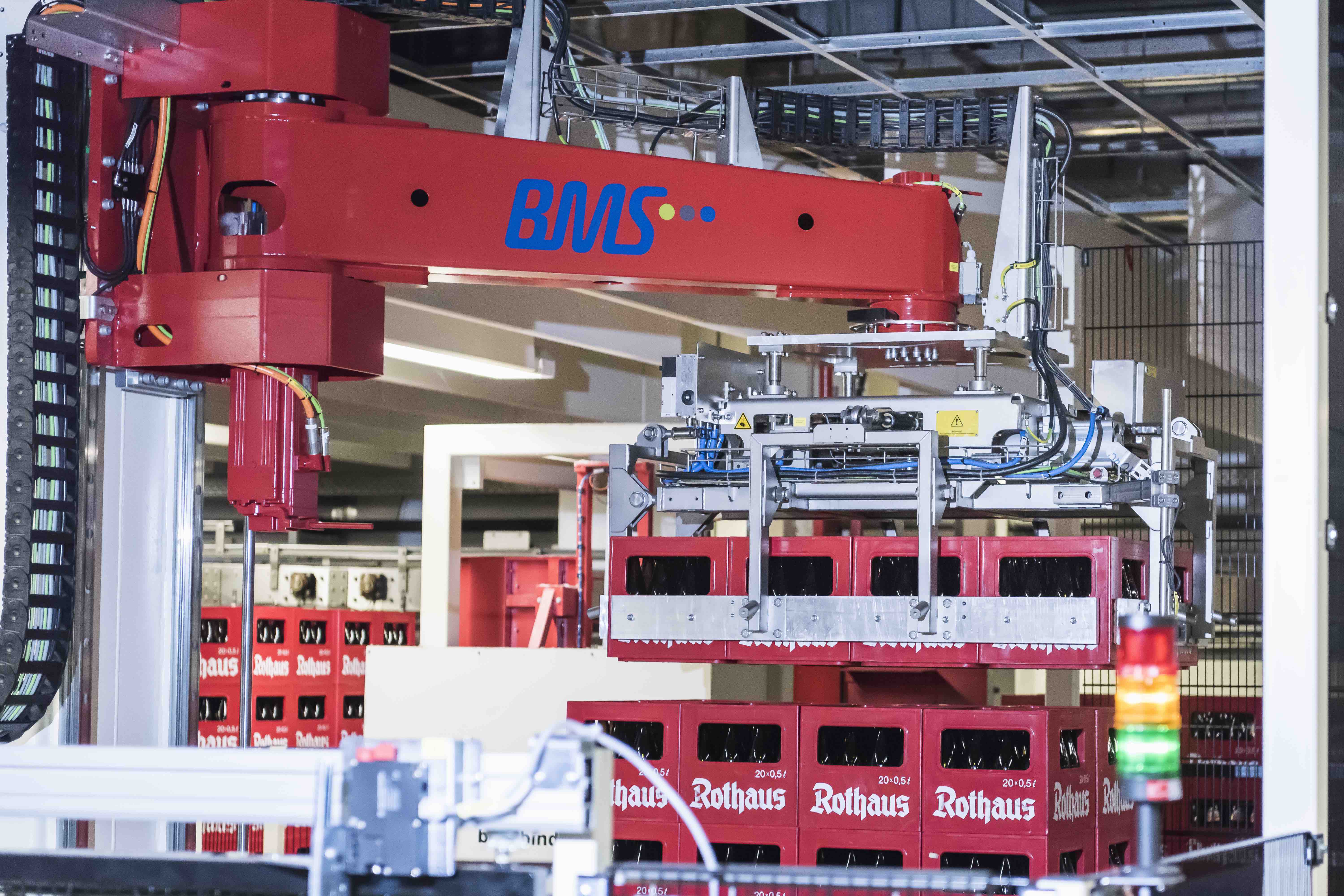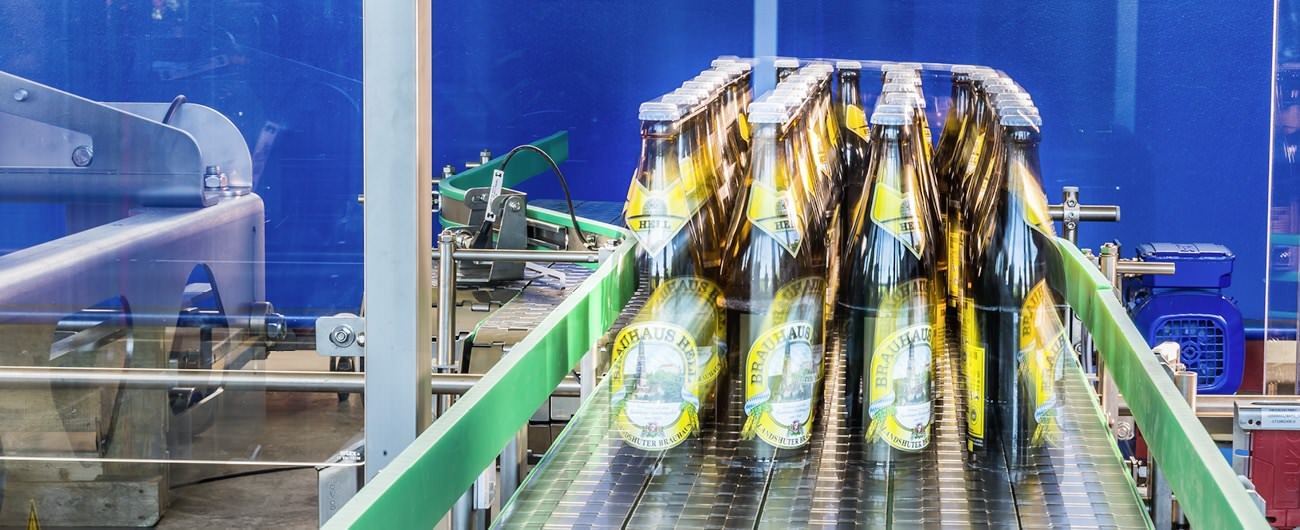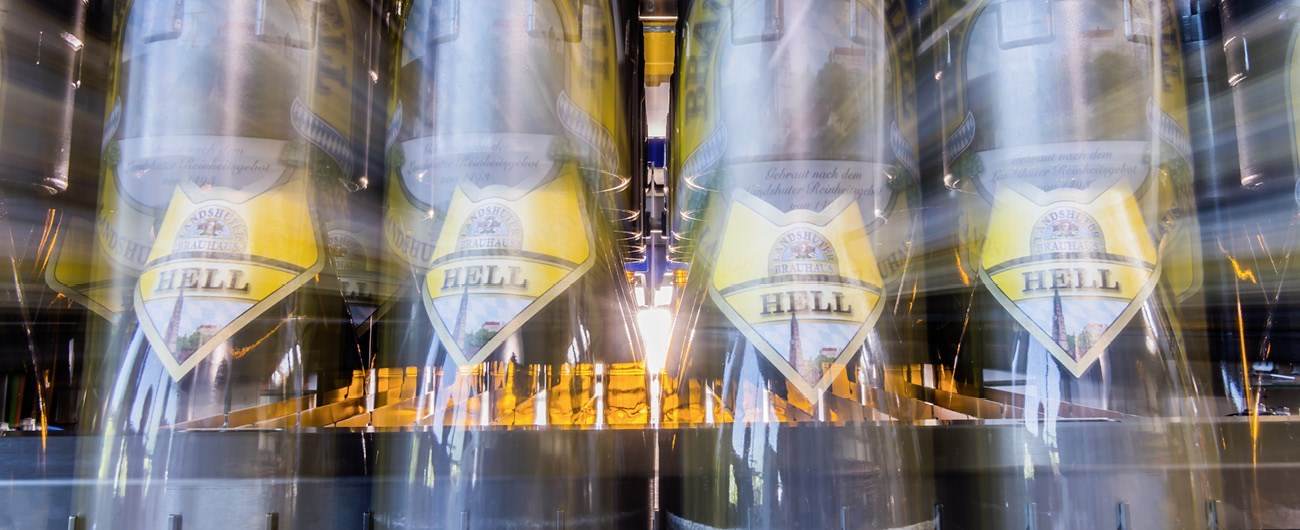Rothaus Brewery modernises its 50,000-bottle glass returnables line in the year of its anniversary
Palletising area including the pallet transport successfully completed.
To make a long story short, there are a minimum of four key factors behind the success of the Badische Staatsbrauerei Rothaus AG: a clear commitment to the home region, the Black Forest, popular beers like the Tannenzäpfle that are well known well beyond regional borders, quality beyond reproach and, last but not least, ongoing investment in technical facilities. In its anniversary year 2021 – Rothaus has been brewing now for 230 years – another major project is underway, the complete modernisation of a 50,000-bottle line for glass renewables. In this project the redesign of the palletising area including the pallet transport has already been successfully completed.
The founding of the Rothaus Brewery in 1791 was for a truly noble purpose: Martin Gerbert, Benedictine prince-abbot, wanted to dissuade the people of the Black Forest from distilling their own schnaps, the so-called “Wässerle“. The prince-abbot was very business minded for his time and wanted to make “his“ region competitive and economically fit, providing an alternative to another brewery in the region. In addition to this, he also founded one of the oldest Sparkasse savings banks in Germany.
Fifteen years later on, due to the secularisation process, Gerbert had to hand everything over to the Baden State which still holds the reins today. And for a good reason too. Although output figures are traditionally not disclosed, Rothaus sales have for years now been relatively steady between 75 and 78 million euro. In 2019, for example, Rothaus and its team of 240 employees achieved sales of 75.8 million euro and earnings before taxes of 15.3 million euro. Even during the Covid-19 pandemic the brewery has held up comparatively well, according to reports. The reasons for this are said to be the increasing popularity of regional beers, a smaller share of draft beers as well as the warm and sunny summer of 2020. So it is definitely a worthwhile undertaking for the state. !
 Brewery anniversary 2021 – This year Rothaus has been brewing for a proud 230 years. To celebrate this, a new major project for the complete modernisation of a 50,000-bottle glass returnables line is being implemented in the Upper Black Forest.
Brewery anniversary 2021 – This year Rothaus has been brewing for a proud 230 years. To celebrate this, a new major project for the complete modernisation of a 50,000-bottle glass returnables line is being implemented in the Upper Black Forest.
The palletising system was becoming a troublespot
There were several reasons for investing in a replacement of the returnables filling line: This filling line dates back to 2003 and was the main plant at Rothaus up until 2018, primarily for the 0.33 litre Tannenzäpfle. “This means fifteen years with intense three-shift operation and this has definitely left its mark. The time had simply come“, Roger Jäger, head of filling at Rothaus recalls. Also the palletising system was from a supplier who has long since left the market. It was becoming more and more difficult to obtain spare parts. Also the version of the loading system was not powerful enough.
Jäger goes on to explain: “It really wobbled during deceleration. A lot of reworking and welding then had to be carried out.“ In short: the palletising system was becoming a troublespot, it needed to be replaced as quickly as possible within the framework of the overall modernisation scheme during which Rothaus also wanted to change the pallet labelling system. “In the warehouse, there was an occasion when the label foils on over 200 pallets were torn. For this reason we decided to use the cord labelling system“, Jäger explains. The first problem with the new layout: “The foil labeller had a significantly smaller footprint and we had to fiddle around until we came up with a suitable solution,” Jäger comments.
Stipulation to only dismantle and assemble, and maintain the use of interfaces
Rothaus wanted no further major changes to the crate infeed and outfeed and therefore stipulated only dismantling and assembly work in the palletising area with the continued use of existing interfaces. This was not going to be easy, but after drawing up several design variants a very good solution was found“, Jäger underscores. Another tricky task awaited, Jäger continues, and this was in the integration of the existing pallet destrapper and the pallet elevator. “The machinery guidelines which have to be implemented with regard to safety have become a real challenge. Especially for existing plants with a defined footprint. However, we were still able to achieve good accessibility to the individual components which is needed for cleaning and maintenance purposes.“
There was also a very hard task to be dealt with at the pallet elevator. Jäger recalls: “The pallet elevator was integrated in the machine control system of the old loading system. This was something we were not really aware of, it was quite a surprise.” On the hardware side, BMS thus had to set up a new stand-alone control system. The control software, on the other hand, was taken over as much as possible in order to have CE certification.
 Whereas BMS previously acted primarily as a machine partner, for example in the area of packaging machines, its area of responsibility was significantly expanded in this project.
Whereas BMS previously acted primarily as a machine partner, for example in the area of packaging machines, its area of responsibility was significantly expanded in this project.
Loader and unloader in column-type design
In terms of machinery, the complete pallet conveying system including the pallet magazine as well as the loader and unloader were supplied. Both are layer palletisers of the type Unipal 108 in column-type design. Both loader and unloader have an output capacity of 2,700 24-bottle crates per hour, and with 20-bottle crates the output is 3,250 crates per hour. Rothaus specifically chose this machine type because: firstly, column-type palletisers were already installed in the old plant. With regard to the layout it was therefore a simple and attractive solution. Secondly, Rothaus has been relying on the Unipal palletiser model since 2017. “We therefore knew that these palletisers feature an extremely stable design and operate with reliable accuracy and precision,” Jäger explains. Also in favour of this choice of machine were similarities in maintenance, spare parts and operation.
Scope of responsibility significantly expanded
The contract was awarded on 11 September 2020. Compared to previous joint projects, Rothaus has significantly expanded BMS’s area of responsibility. “Previously BMS acted primarily as our partner for machines, now they were responsible for the entire package, from the layout and the components to dismantling and selling of the old plant, to assembly, automation as well as commissioning, including the training of operators“, Jäger adds.
The dismantling of the old plant started on 06 February 2021, production start-up took place in calendar week 8. Since then, pallets with empties are being conveyed to the palletising level via the elevator as before. “We still have a real bottle cellar,” Jäger adds, grinning slightly. It is followed by the destrapper, then the unloader. The empty pallet is conveyed from here to the magazine where it is buffered. This is a key function because due to the storage capacity, Rothaus drives the empties pallets six-crates high into the warehouse, and in this way also into the filling lines. The full goods, however, leave the filling line only five crates high. As a result of this there is a shortage of pallets for the full goods, whereas there is a surplus of pallets for the empties.
 Already completed: the redesign of the palletising area including pallet transport and pallet magazine.
Already completed: the redesign of the palletising area including pallet transport and pallet magazine.
Magazine buffers pallets fully automatically
Missing pallets can be manually fed into the magazine via a loading station or stored at two separate buffer stations. If there is a surplus of pallets, for instance when the line starts – the surplus pallets are temporarily stored in the magazine and the buffer stations and then conveyed to the loader as required. If there is still a surplus of pallets, Rothaus removes the corresponding blocks manually. Alternatively, new pallets can also be fed in via this stream. Downstream of the loader the pallets are secured as required with cord labelling. The full goods pallet is then conveyed by the elevator to the discharge level.
Loader processes up to three streams of packs
The identical type of machine has been installed as loader and unloader. “With regard to the palletisers it makes no real difference from a design point of view whether they transfer full or empty goods”, Jäger assures us. The loader was given three bays as a special feature. Jäger goes on to explain: “In the filling line we have the option of sorting empties inline. In this case, two additional crate streams are fed to the loader.” These are firstly Rothaus crates with third-party bottles and secondly sorted Rothaus glass bottles.“ Our crates feature identical dimensions, so there are 0.5 litre crates and 0.33 litre crates on the pallets. If, for example, we now fill 0.5 litres, then our sorted 0.33 litre crates are conveyed on the second stream. The third stream conveys the then filled goods, in this case 0.5 litre crates,” Jäger explains. Depending on the situation in the buffer line the three streams are called up accordingly and are placed on pallets by the loader and then conveyed to warehouse logistics.
 Rothaus chose a column-type palletiser for both the loader and the unloader.
Rothaus chose a column-type palletiser for both the loader and the unloader.
A completely new challenge – the Corona pandemic
It was indeed an unprecedented challenge that was then faced during the actual processing of the project - the strict Covid hygiene measures. Jäger continues: “During this phase we had to run the entire filling programme on our second plant. It was therefore vital that all deadlines were met, in spite of the difficult conditions and restricted direct communication – and it all went well.” The cloud-based construction site management system LOP 4.0 played an important role in this respect. All parties involved in the project can access this cloud solution via the BMS homepage using a password. No special software is required. Data security is ensured at all times.
This digital project platform maps the current status with the highest possible transparency during the construction site phase, from delivery right up to commissioning. Here, among other things, it gives a graphic display of how many jobs are currently outstanding, in progress or completed. A filter function also allows the information to be generated quickly and in a targeted manner. Another feature is a digital material list that acts as a push client.
LOP 4.0 is furthermore an open communication and documentation platform. Each project partner can, for example, upload photos or videos, propose next steps or prioritise individual items. This makes sure that the status of all project modules is always up to date and clearly understandable. Any interactions with the next steps can thus be seen immediately. This reduces conflict and coordination losses and leads to a high level of planning ability.
 Problem solved: Machinery guidelines with regard to safety are a real challenge for the planning, especially in the case of existing plants with a defined footprint and specified interfaces.
Problem solved: Machinery guidelines with regard to safety are a real challenge for the planning, especially in the case of existing plants with a defined footprint and specified interfaces.
Clear positive effects through LOP 4.0 and “Virtual Commissioning“
“Despite Covid-19, the overall execution within the scope of the project was simply faster compared to previous projects, showing the clear positive effect of LOP 4.0. The “virtual commissioning” certainly contributed to this development as well,” Jäger points out. This computer-aided simulation tool is also an in-house development of BMS. Using this tool it is possible to carry out process engineering and commissioning of the software in parallel. In this process, the actual PLC of the machine is given concrete tasks and challenges by a simulated model. For example, the virtual model sends a signal to the PLC which then drives a virtual motor faster. The commissioning engineer can therefore see whether the actual value matches the target value, before getting to the construction site. Or whether, in the case of a simulated sensor defect, all fault messages are programmed correctly. In this way, the commissioning of the machine or plant at the customer’s premises is optimised decisively.
The final question is then: is Rothaus satisfied once again with the execution of the project and the plant performance? „Absolutely.” Jäger concludes. “From planning right through to the commissioning, the implementation went extremely well in every respect. Particularly exemplary was the way in which any required optimisation work was openly approached.” Rothaus can now, in the year of its anniversary, tick off this major modernisation step as accomplished and is more than happy to share a Tannenzäpfle with us.
Published in: Brauwelt International
Want to read the full article? Click HERE to dowload the report!




